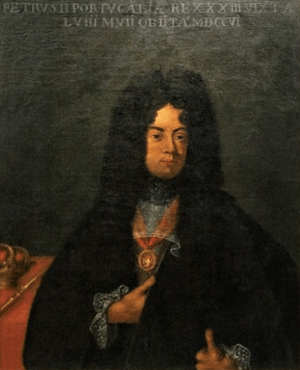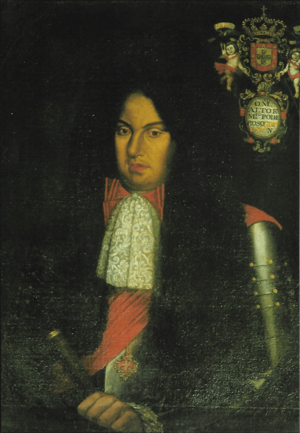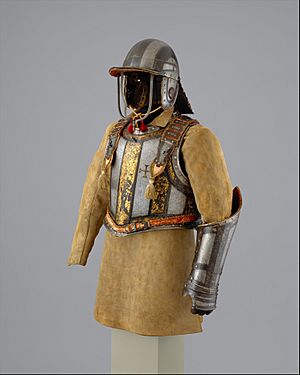Peter II of Portugal facts for kids
Quick facts for kids Peter II |
|
|---|---|

Portrait by Miguel António do Amaral
|
|
| King of Portugal | |
| Reign | 12 September 1683 – 9 December 1706 |
| Predecessor | Afonso VI |
| Successor | John V |
| Regent of Portugal | |
| Regency | 27 January 1668 – 12 September 1683 |
| Monarch | Afonso VI |
| Born | 26 April 1648 Ribeira Palace, Lisbon, Portugal |
| Died | 9 December 1706 (aged 58) Palhavã Palace, Lisbon, Portugal |
| Burial | Pantheon of the House of Braganza |
| Spouse |
Maria Sofia of Neuburg
(m. 1687; died 1699) |
| Issue Detail |
Isabel Luísa, Princess of Beira João, Prince of Brazil João V Infante Francisco, Duke of Beja Infanta Francisca Infante António Infanta Teresa Infante Manuel Infanta Francisca |
| House | Braganza |
| Father | John IV of Portugal |
| Mother | Luisa de Guzmán |
| Religion | Roman Catholicism |
| Signature |  |
Peter II, also known as "the Pacific", was a king of Portugal. He was born on April 26, 1648, and passed away on December 9, 1706. Before becoming king in 1683, he was a regent, which means he ruled for his brother, Afonso VI, starting in 1668. Peter was the youngest of five children born to King John IV and Queen Luisa de Guzmán.
Contents
Early Life and Becoming Regent
Peter was the third son of King John IV and Queen Luisa. He was given the title of Duke of Beja.
After his father died, his mother became the regent for the new king, Afonso VI. Afonso was Peter's older brother and had some health challenges. In 1662, Afonso took control of the country. However, in January 1668, Peter gained more power than his brother. He was then made regent, meaning he ruled in his brother's place. Afonso was sent away and later died in 1683. After Afonso's death, Peter became the king.
Peter not only became king but also married his brother's former wife, Queen Maria Francisca of Savoy (1646–1683). They had one daughter, Isabel Luísa, Princess of Beira (1669–1690), who was expected to inherit the throne.
Peter II's Rule: Strengthening Portugal (1668–1706)
Peter made Portugal's independence stronger by signing the Treaty of Lisbon in 1668. This treaty ended the Portuguese Restoration War, which had started in 1640.
He formed a strong alliance with England. This alliance was helped by the marriage of England's King Charles II to Peter's sister, Catherine of Braganza, in 1661. As part of this agreement, Portugal gave England Tangier and Bombay as a gift. Portugal also agreed to share trade and give English families special rights in some Portuguese cities. In return, England promised to help Portugal militarily, protecting its ships and coasts.
This alliance with England was very important for Peter's leadership. He brought more power to the monarchy and reduced the power that noble families had gained after his father's death in 1656.
Key Achievements and Policies
Peter's long rule saw many important achievements. In 1671, he allowed English people living in Portugal to trade freely. He also started setting up factories to make textiles (cloth).
In 1674, his daughter, Isabel Luísa, was declared the heir to the throne. Peter also created a special law about how kings would be ruled if they were too young.
A major concern for Peter was improving Portugal's defenses. He asked for money to keep border guards and repair castles and forts. The main worry was protecting the coast. Portugal sent a fleet of 11 ships in 1675 to protect its valuable shipments from India and Brazil.
Marriages and Royal Family
There was a rule that prevented Peter's daughter, Isabel Luísa, from marrying a foreign prince. This rule was changed in 1679. However, the planned marriage to her cousin, the Duke of Savoy, did not happen.
In 1683, Queen Maria Francisca died. Peter then married Maria Sophia of Neuburg, who was the sister of the Queen of Spain. Maria Sophia did not get involved in politics. They had eight children together. Their youngest son, John, later became King John V of Portugal in 1706.
Portugal's Role in Europe

At first, Peter supported France and Spain in the War of Spanish Succession (1701–1714). But on May 16, 1703, Portugal and England signed the Methuen Treaty. This agreement gave special trading rights for Portuguese wine and English textiles. It also gave England a lot of influence over Portugal's economy.
Later, in December 1703, Portugal, Austria, and England formed a military alliance to invade Spain. Portuguese and Allied forces captured Madrid in 1706. However, this campaign ended in defeat for the Allies at the Battle of Almansa.
Developing Brazil
Peter helped develop Brazil, which was a Portuguese colony. He got approval from the Pope to make the church in Bahia a higher-ranking archbishopric. He also created new bishoprics (church districts) in Olinda and Rio de Janeiro in 1676.
In 1684, there was a revolt in Maranhão, Brazil. Colonists protested against a company that had a monopoly on trade. There were also uprisings by the Tapuias people in the 1680s.
The discovery of gold in Minas Gerais, Brazil, in the late 1600s brought a time of great wealth. In 1693, the area became the Captaincy of São Paulo and Minas Gerais. Peter encouraged more mining.
The Casa da Moeda do Brasil (Brazilian Mint) was created on March 8, 1694. This mint made the first Brazilian coins to be used within the colony. These new coins helped the economy in Brazil.
By the end of Peter's rule, there were two main problems in Brazil. One was a dispute over Colonia del Sacramento, a territory that was recognized as Portuguese but was taken by the Spanish in 1705. The other was conflicts between different groups of people looking for gold.
Death and Legacy
Starting in 1703, King Peter experienced periods of deep sleep. Doctors thought it was a severe throat infection. On December 5, 1706, he became very ill with a lung infection and lost consciousness. He passed away on December 9, 1706, at Palhavã Palace in Lisbon. It is now believed he had a liver disease.
Peter II was the last surviving child of John IV of Portugal. He is buried in the Pantheon of the Braganzas in Lisbon.
Historians describe Peter II as a tall, strong man who enjoyed horseback riding and bullfighting. He was known for having a great memory and always listening to people. He liked to hear many opinions, which sometimes made him take a long time to make decisions.
His main goal was to rebuild Portugal after years of war. From 1693, gold from Brazil helped greatly with this effort. He earned the nickname "the Pacific" because peace was made with Spain during his time as regent in 1668.
Marriages and Children
Peter II was married twice and had several children, including some born outside of marriage.
- With Marie Françoise of Savoy-Nemours (married 1668):
- Infanta Isabel Luísa of Portugal (born 1669, died 1690)
- With Maria Sophia of Neuburg (married 1687):
- João, Prince of Brazil (born 1688, died 1688)
- John V of Portugal (born 1689, died 1750) – He became King of Portugal after his father.
- Infante Francisco of Portugal (born 1691, died 1742)
- Infanta Francisca Xaviera of Portugal (born 1694, died 1694)
- Infante António of Portugal (born 1695, died 1757)
- Infanta Teresa Maria of Portugal (born 1696, died 1704)
- Infante Manuel of Portugal (born 1697, died 1766)
- Infanta Francisca Josefa of Portugal (born 1699, died 1736)
- Children born outside of marriage:
- Luísa de Braganza (born 1679, died 1732)
- Miguel of Braganza (born 1699, died 1724)
- José de Braganza (born 1703, died 1756) – He became an Archbishop.
Images for kids
See also
 In Spanish: Pedro II de Portugal para niños
In Spanish: Pedro II de Portugal para niños



